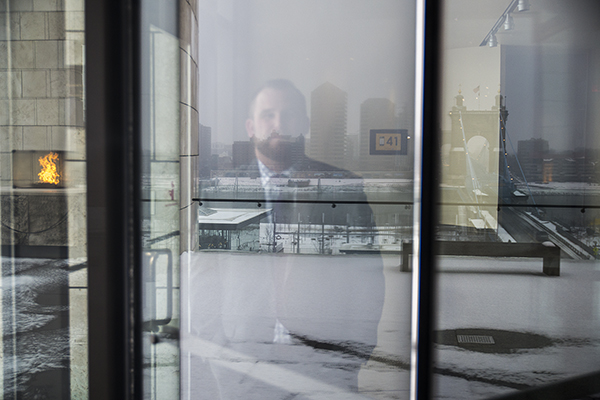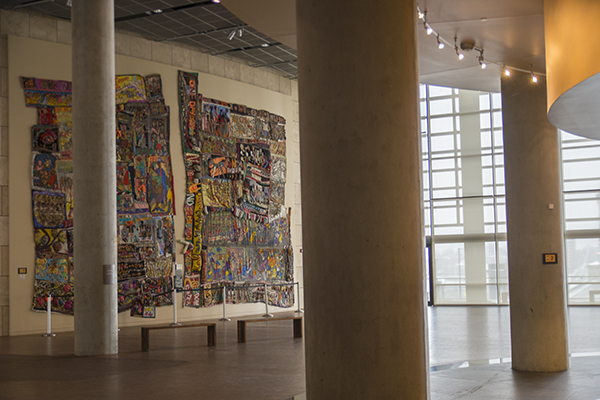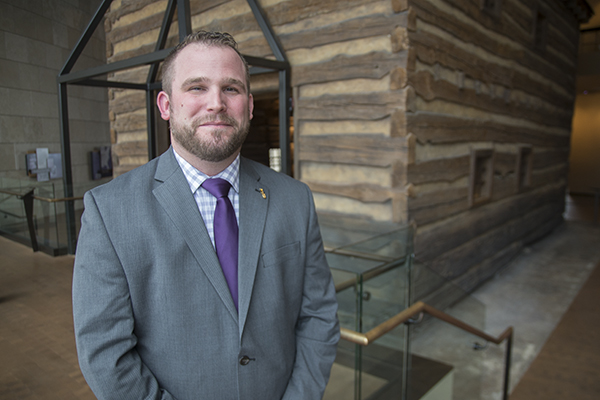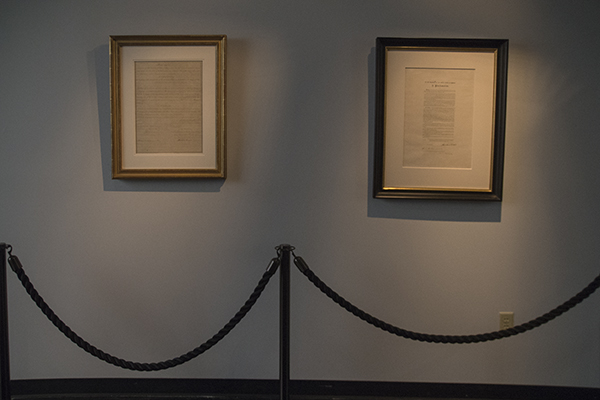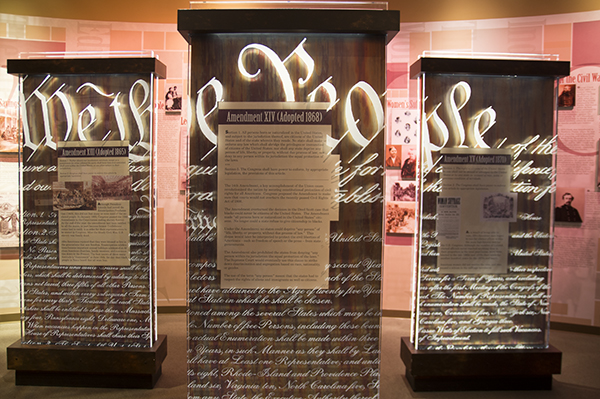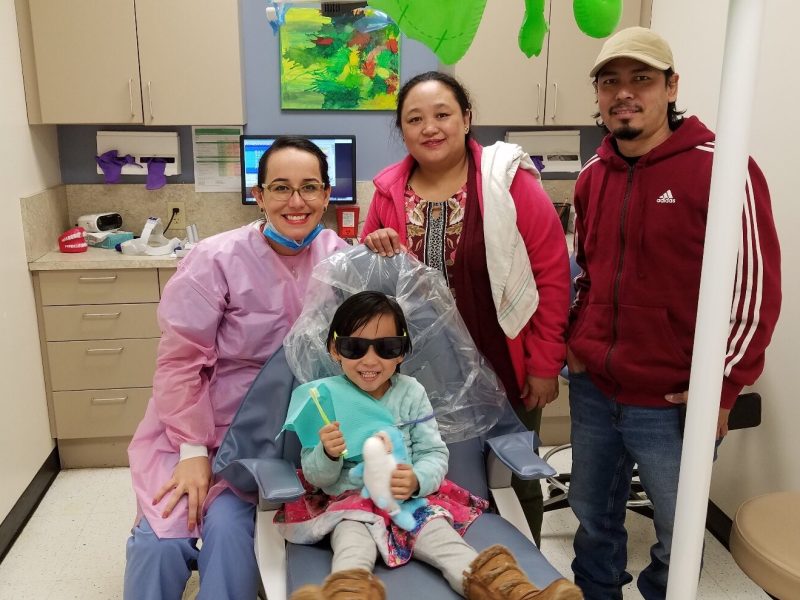Stories That Have to Be Told: Rich Cooper helps the Freedom Center stay relevant
Rich Cooper has stuck with the National Underground Railroad Freedom Center through thick and thin, serving now as Director of Museum Experiences as the organization finds its footing locally and nationally.
Rich Cooper he has worked at the National Underground Railroad Freedom Center for nearly its entire existence.
He started as Interpretive Services Coordinator and quickly moved up through the ranks, serving now Director of Museum Experiences in charge of exhibits, education initiatives, the volunteer program and practically everything in between.
Cooper has worked with foreign ambassadors on diversity programming, led two U.S. Attorneys General and a Speaker of the House on tours of Freedom Center exhibits, met Desmond Tutu and the Dali Lama during their visits to Cincinnati and interacts regularly with Nelson Mandela’s family and foundation.
So when asked what accomplishment he takes the most pride in, you wouldn’t expect him to quickly respond, “I think the thing I’m most proud of is making my mom and dad proud of me.”
Cooper is a lifelong Cincinnatian, raised in North College Hill and now living in Morrow. He earned degrees from the University of Cincinnati and Northern Kentucky University in American history and public history, respectively.
He talks a lot about his family. His father has worked for U-Haul since Cooper was young, and his mother had a career as a home nurse aid. His two sisters, he says, “are brilliant, smarter than me. All of them were incredible role models for me.”
It takes him no time to recall where the passion for his work was sparked.
“Looking back at my childhood, I can see where my love for history grew from,” Cooper says. “My dad would come home from work and put on the History Channel. I wanted to spend time with him, so I would go in and sit there with him, hating the History Channel. But as I sat there hating it, all of these thoughts of history starting building in my head. Flash forward 15 years, and I’m a history major.”
Tracking the Underground Railroad
Even before graduating college, Cooper was already beginning to focus on the area that would become his life’s work. An undergraduate professor and early mentor, Dr. Keith Griffler encouraged his interest and inspired him to explore African American history, Cooper says. His undergrad thesis centered on Cincinnati’s Union Baptist Church, specifically its record keeping.
“They are some of the best kept records of any African American church in the country,” Cooper says. “The level of detail to which they recorded things was what made it most interesting.”
The archives record the establishment of black primary and secondary schools, orphan asylums and funds that helped support freed slaves and in some cases even buy people out of slavery.
“Keeping records of those kinds of activities at that time in history was very dangerous,” Cooper says.
His master’s thesis then focused on Cincinnati’s role in the Underground Railroad, and his work has been pared down into a book, Cincinnati’s Underground Railroad. It’s no surprise, then, that he sought out the National Underground Railroad Freedom Center upon graduation.
Through its first decade of existence, the Freedom Center has seen its ups and downs. Economic challenges, staff downsizing and leadership turnover have frequently and unfortunately made more news than many of the exhibits that have occupied its halls.
Recently, however, the tide has turned and the momentum shift is significant.
Certainly there are a number of reasons for this dramatic turnaround, starting with the merger with Cincinnati Museum Center that Cooper says expanded the scope and scale of what’s possible at the Freedom Center, including making it a collecting museum. He also points to the additions of C.G. Newsome as President and Michael Battle as Provost, bringing with them a refined approach to exhibits and programming that focuses on leading conversations through exhibits and events.
What he won’t say — but others will quickly point to — is that the Freedom Center’s turnaround is also attributable to Cooper’s own longevity, insights and dedication to the museum’s core mission.
Sure, he’s been tempted to leave, even encouraged to do so by some colleagues and peers — especially during the hard times.
“I was asked that question by many in the field: ‘Why do you stay? When are you going to take the next step in your career?’” Cooper says. “But when I close my eyes, I just can’t imagine being anywhere else right now.”
Conversations and storytelling
Despite all of his positivity, Cooper does admit that the Freedom Center’s subject matter can be emotionally difficult to manage at times. Exhibits run the spectrum from uplifting success stories found in the Diversity in Baseball exhibit he created in honor of Cincinnati hosting the 2015 All-Star Game to graphic imagery featured in 2010’s Without Sanctuary exhibit of African American lynchings dating from the late 1800s through the mid-1900s.
In discussing the latter, Cooper explains his process for vetting photos for the exhibit.
“I had to pour over these photographs and learn everything I could about them,” he says. “I had to scrutinize them for historical significance and make sure our accompanying texts were accurate. I spent days looking at these photos, some of which were used as postcards to promote a lynching as an event to attend. And it got to me. After a couple of days, it got to me.”
Still, when asked how he keeps from getting lost in the innate sadness that comes from some of his day-to-day work, Cooper simply says, “These are stories that have to be told. They can’t be forgotten. African American history is American history.”
In a time when even school textbooks can gloss over controversial parts of our collective history, Cooper’s work at the Freedom Center seems more important than ever. Conversation is encouraged at all times.
“Even around the most toxic issues, there is room for conversation,” Cooper says.
He describes the town hall forum the Freedom Center hosted following the fatal shooting of Sam Dubose. It wasn’t set up to be a one-sided, agenda-driven declaration but rather a thoughtful, inclusive and purposed discussion aimed at representing a variety of perspectives.
The invitation list was all-inclusive: Dubose family members and lawyers, Officer Ray Tensing’s family members and lawyers, City Manager Harry Black, members of the media and police department leaders. They all came together in one room to talk civilly about the tragedy.
“It was a very important conversation,” Cooper says. “We want both sides present to talk about the issues. We help create empathy. As a society we’ve jumped away from that. We’re yelling at everyone. Not listening to anyone. When you bring diverse groups of people together, they see the differences between us aren’t really that different.”
‘You can’t do that anywhere else’
Impact can be measured in many ways. Cooper points to the fact that town halls and other presentations have more than doubled attendance at live Freedom Center events in the last year. Fundraising for the museum has also seemingly turned a corner, as goals are being met and exceeded. They’ve been able to slowly add essential staff back into the mix.
But while those metrics are key, Cooper says he’s witnessing much more important long-term advancements at the Freedom Center. He tells a number of stories about times when none of the traditional markers of success may have applied but human compassion, love, empathy and healing won the day.
Like when 30-40 friends and family members of Kelsie Crow came to see the Kin Killin’ Kin exhibition, which just closed last week. In development for almost five years, it featured artwork by SCPA grad James Pate focused on violence in inner city communities.
Crow was a Purcell Marian High School student killed by stray bullets from a gun battle last year in Walnut Hills.
Cooper describes watching this group slowly make its way through the exhibit, each of them pausing by a memorial placard bearing Crow’s name illuminated by a single candle on a small shelf beneath it.
“They would each stop and place their hand on her name and take a moment,” he says. “Tears were flowing.”
As the group concluded its tour, they approached Cooper and thanked him, offered a picture of Crow that he still keeps on his desk.
“I feel like we helped Kelsie’s family no matter how little,” he says. “There were no words. You just can’t wrap your mind around what they’re feeling. But to see that we can add some comfort through an exhibit … you can’t do that anywhere else.”
Another such moment occurred late one afternoon when most of the city was being shut down by snow during the run of Without Sanctuary.
“During a big snowstorm, I was there almost alone, waiting for the last patrons to leave so we could close early,” Cooper says. “There was one person in the gallery, a 40- to 50-year old African American man. He spent two and half hours in the exhibit, which was odd because it was a fairly small room. As he was travelling through the gallery, I checked in on him to see if he had questions or wanted to talk about anything. I could see that he was having a very difficult time with the material as he was going through.
“He finally came out of the back of the gallery and was crying. He took a moment to collect himself and then looked up at me. And for the first time I can remember, I was actually speechless. He walked up to me and said, ‘Thank you for doing this exhibit. My grandfather fought in World War II. He survived his tour in the war but never made it home. After getting back to the United States, he was lynched while making his way home.’ He thanked me again, hugged me and left.”
The Freedom Center is a national museum with an outstanding reputation across the country and around the world, but it’s only now beginning to be widely acknowledged in Cincinnati. That doesn’t seem to bother Cooper.
“I can’t think of another city in America that has a story to tell like the city of Cincinnati,” he says.
It’s clear he won’t rest until we all know more of that story.

